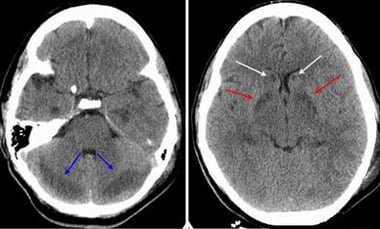
Swelling, referred to medically as edema, is the body’s natural response to many types of injury. Swelling can result from overuse, infection or trauma and can often times be simple to treat with some combination of rest, ice, elevation, medication, and/or removal of excess fluid. However, when swelling occurs in the brain, the condition must be recognized and treated quickly to prevent permanent brain injury. Brain swelling can also be referred to as:
- Brain edema
- Elevated intracranial pressure
- Cerebral edema
Cerebral edema is a dangerous condition where the water content within brain tissue rises, causing the pressure to rise inside the skull. Unlike swelling in other parts of the body, where there is room for extra fluid, for example a sprained ankle, the brain is protected by the hard, inflexible skull with very little room to accommodate expansion.
Brain swelling (edema) increases pressure inside the skull which pushes back against the brain itself. This is known as intracranial pressure or ICP. If the pressure is not relieved, the brain’s oxygen supply can be cut off as blood vessels are literally squeezed shut. Neuron cell death (apoptosis) begins after just four minutes of oxygen deprivation. When cerebral edema develops, doctors sometimes perform a craniotomy – a procedure in which the skull is vented or ported to relieve the pressure inside it.
Primary Causes of Cerebral Edema
Trauma and other health problems can result in brain edema. Trauma is caused by some external force acting on the head or skull. Common health problems associated with edema and ICP are often linked to strokes. The following lists a few different causes of cerebral edema:
- Traumatic brain injury (TBI): A traumatic brain injury is also referred to as a head injury, brain injury, or acquired brain injury. In instances of traumatic brain injury, some form of physical trauma damages the brain. Either a sudden, direct impact or a rapid acceleration and deceleration of the head can stress brain tissue and cause injury. The most common causes of traumatic brain injury include falls, automobile accidents, falling or swinging objects, explosions (IEDs in combat) and assaults. Traumatic injury can cause brain tissue to swell. Broken pieces of bone may rupture blood vessels in any part of the head. The body’s response to the injury may also exacerbate swelling. Too much swelling can prevent fluids from draining from the brain naturally, increasing ICP further.
- Ischemic stroke: Ischemic stroke is the most common type of stroke. It is caused by a blood clot or blockage in or near the brain. The clot stops the brain’s supply of oxygenated blood necessary for normal brain cell functions. As a result, neurons start to die off. As the brain responds, swelling in the injured areas can occur.
- Intracerebral (brain) hemorrhages and strokes: The term hemorrhage refers to blood leaking from a blood vessel. Hemorrhagic strokes are the most common type of brain hemorrhage. They occur when blood vessels anywhere in the brain rupture. As blood leaks and the body responds, pressure builds inside the brain. High blood pressure is thought to be the most frequent cause of this kind of stroke. Hemorrhages in the brain can also result from trauma, certain medications, and unknown malformations present from birth.
References:














